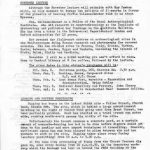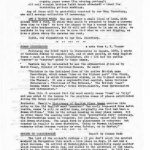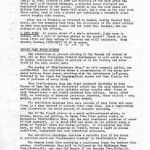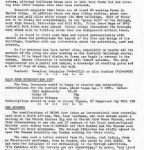Newsletter
Page 1
November Lecture
Although the November lecture will coincide with Guy Fawkes night, we urge members to forego the delights of fireworks in favour of the pleasure of hearing Portia Wallace-Zeuner talk to us about Mycenae.
Mrs. Wallace-Zeuner is a Fellow of the Royal Anthropological Institute. She did research in dendrochronology at the Institute of Archaeology and published her findings in the Institute Bulletin. She has been a tutor in the Extra-mural Departments of London and Oxford universities for fifteen years.
Her present day field-work centres of archaeological sites in the Mediterranean doing Museum research and photography for current courses. She has studied sites in France, Italy, Greece, Turkey, Syria, Lebanon, Jordan, Egypt and Tunisia, including the islands of Crete, Delos, Sicily and Sardinia.
5 November will be a HADAS meeting you can’t afford to miss. Come to the Central Library, at 8.00 for coffee, followed by the lecture.
The other dates in this winter’s programme will be:
Friday Dec. 6 – Christmas Party, 166 Station Road, NW4. Starts 7.30 p.m.
Tuesday Jan. 7 – Mucking, Essex, Crop-mark Sites – M. U. and W. T. Jones
Tuesday Feb. 4 – The Lunt Roman Fort, Warwicks – Excavation and reconstruction – Brian Hobley
Tuesday March 4 – Medieval Jewellery and Pottery – John Cherry
Tuesday April 1 – Are We Fair to Neanderthal Man? – Desmond Collins
Digging and Pottery Processing
Digging has begun on the latest HADAS site — Fuller Street, Church Road, Hendon, NW4. The site, which is behind a large advertisement hoarding on the right of Church Road going west from Brent Street, has been partially gridded. Work has started on a trial trench 1 metre wide, running North-South across the middle of the site.
Unfortunately the trench crosses a concrete yard, so a certain amount of concrete-bashing has had to be done before diggers could get down to the gentler and more expert techniques of trowelling. However, sufficient space has now been cleared to allow between six and ten members to work on the site. Digging takes place every Sunday (weather permitting) from 10.00 a.m. to 5.30 p.m.
At the same time processing of finds from the Church Terrace dig it goes on, also every Sunday from 10.00 a.m. to 5.30, in the temporary workshop which the Borough has lent us behind the PDSA building on the corner of Church Road and Church End.
This means there is work for everyone, either digging or helping with pottery, wet or fine, every Sunday; many hands are needed and will be made very welcome. Please come as often as you can. If you don’t find anyone at the workshop, walk down to the dig — or vice versa.
No digging or processing on Sunday October the 6th, due to the HADAS weekend visit to Shropshire. No work, either, on Saturdays at present. This situation may change if the trial trench at Fuller Street produces any interesting finds.
Page 2
Digging Needs
Have members any of the following which they would be prepared to add to the Society’s equipment:
Metal meat skewers (for stringing out trenches);
Seed trays, tomato boxes or other shallow, stout boxes (for use as finds trays);
The strong, cube-shaped cardboard boxes in which Xerox copying paper comes (for storing pottery);
Old nail varnish bottles (with brush attached) — ideal for vanishing pottery markings.
Any of these will be gratefully received by our Hon. Secretary, who will arrange collection if necessary.
And a bigger need
Has any member a small piece of land, with access from a road, on which they will be prepared to house a caravan from time to time? We have the chance to buy a second-hand caravan to use as site headquarters, but it will not always be in use on site. We hesitate to buy until we can be sure that when we are not digging, we have a place where the caravan can rest.
Again, any suggestions to our Hon. Secretary.
Roman Cirencester
A note from A. V. Turner.
Following the HADAS visit to Cirencester in August, 1973, I wrote to Corinium Museum to inquire why, and at what period, so many English towns — such as Winchester, Gloucester, etc., had had the suffix “cester” or “chester” added to their names.
Members may be interested to see the explanation given me by David Viner, Curator of Corinium Museum. He says:
“Corinium is the Latinised form of the native British name Caer-Coryn, which means “town on the highest part” (the Churn, the river on which Cirencester a stands, is the highest source of the Thames). It was a regional tribal capital, hence Corinium Dobunnorum – “Corinium of the Dobunni”. The British “Caer” becomes Saxon “caestre”, hence Coryn-caestre, then Cyrenceastre and Cirencester.”
From this it appears there the word merely means “town” or “city” and was added by the Saxons to the previous names of places established during the Roman occupation.
Footnote: Ekwall’s DICTIONARY OF ENGLISH PLACE NAMES carries this entry on the old English word “ceastre”: an early loan-word from Latin castra, which means “a city or walled town, originally one that had been a Roman Station”. This is the actual meaning of many place names; but in other cases the meaning must have been “prehistoric fort” generally. The Northumbrian names in -chester, for instance, cannot all denote old Roman stations. The usual form in place-names is -chester; but –caster is regular in some districts. Owing to Norman influence, -chester often becomes –cester or even -ceter, as in Exeter.”
Outing to Warwickshire
Report by Joanna Wade.
The last of the season’s outings — if you don’t count the special weekend in Shropshire this month — took place on 14 September and was a great success. We arrived at Wormleighton in beautifully sunny weather which remained the whole day, and walked into the gatehouse of the manor, built by the Spencers in 1519 but now mostly destroyed. In 1506 the Spencers had bought, for £2,000, the large pastoral estate, which included the site of a village that had been de-populated in 1499. They themselves built another small village on the other side of the Church from the deserted one. There are still houses on the second site today.
Eric Grant, without whose help I would never have been able to understand the tantalisingly un-excavated bumps, guided us round of the site. Standing in the main street as we approached were some friendly bullocks, which followed us to the manor moat and, I am afraid, distracted many of us from the proper appreciation of the fishpond and stew ponds. The older and newer villages were both fascinating to the visit, and I was sorry to leave so soon. Lunch was on Burton Dassett Hill, with views of Warwickshire and Oxfordshire on all sides.
Page 3
Afterwards we drove over Edge Hill, site of the Civil War battle of 1642, to Compton Wynyates — a beautifully mellow and friendly house (built in 1480, altered in 1520 and deprived of its moat after the Civil War) with twisted chimneys, a peaceful inner courtyard and topiary-ed hedges in the garden. Inside we saw the room where Sir William Compton’s friend Henry VIII slept, and a room in the roof with three exits, used to hide a priest and containing a makeshift altar carved roughly with crosses.
After tea in Shipston we returned to London, having thanked Eric Grant, who had compered this trip, and the organisers of the other outings in this very successful season and not least Mrs. Newbury, who co-ordinated all the efforts.
A 1974 find
Is anyone short of a man’s raincoat, light navy in colour, with a pair of leather gloves in the pocket? Found on the coach after our July outing to Danebury and still unclaimed. Ring Dorothy Newbury if it is yours.
Church Farm House Museum
The exhibition at present showing at the Museum (it closes on October 13th) on Blue Underglaze Printed Earthenware is well worth a visit by anyone interested either in pottery or in the history and artefacts of the more recent past.
The heyday of “Staffordshire Blue”, as it’s commonly called, was c 1795-1845. The exhibition shows a cross-section of the wares produced between these years, starting with the chinoiserie influence, followed by the vogue for topographical scenes and then finally the use of patterns of every kind.
When Staffordshire Blue was first produced (probably by John Turner of Lane End in the Potteries) cobalt was the only chemical base sufficiently stable to give reliable colour results when fired at high temperatures — and cobalt produces blue pottery. Later, about 1835, as knowledge of chemical process is improved, other colours — red, purple, green and brown — also became common.
The exhibition displays blue ware vessels of many forms and uses; there is a case devoted to colours other than blue; and a fascinating case illustrates the whole process of transfer printing.
One of the finest pieces is a small multi-coloured plate, in greens, mauves and yellows, by Spode (the first potter really to popularised Staffordshire Blue, and the most consistent producer of wares of high quality). It is dated 1815 and shows as its central scene a group of “bottle” kilns for firing pottery. It illustrates how this ware, as well as being pleasing in itself, throws a light on social conditions, topography and even industrial processes.
The exhibition catalogue contains a valuable list of ten books or articles which are “recommended reading” on Staffordshire Blue.
The Museum looks like providing a continuous feast for members this autumn. Staffordshire Blue will be followed by Old Middlesex Maps (October 19th-November 24th); and then Old Houses of the Borough (November 20th-January 5th).
HADAS book box
With winter meetings about to start, members are reminded that HADAS now has its own book box, in the capable hands of George Ingram. There are well over 100 volumes, which is too many to bring to each lecture. Mr Ingram will, however, provide a selection each month; and will be happy to supply any member with information about the books available. Consult him at meetings or ring him.
Page 4
Recent Bookbox accessions include
Notes on Nonsuch, a lost Tudor Palace (from Mary Macalaster)
Camden History Review No. 1 (from Brigid Grafton Green)
The London Archaeologist (quarterly) winter 1968 to spring 1974 (all Vol. 1 and Vol. 2 1-6) (from Mrs. Worby)
Rescue News, Nos. 2-5 (also from Mrs. Worby)
HADAS Farm Survey
By Rosalind Batchelor.
The Industrial Archaeology Group is at present concentrating on a survey of farm buildings in the Borough of Barnet. The main aim of the project is to identify, visit and record farms which are still active, although buildings known once to have been farms but now serving some other purpose have also been included.
Research suggests that there are at least 20 working farms in Barnet today. In addition there are many riding stables, plant nurseries and golf clubs which occupy old farm buildings. Most of these are to be found, not surprisingly, in the “green belt” of the Borough, near High Barnet, Totteridge and Mill Hill. Tithe Award Maps of 1843 indicate that farms were spread fairly evenly throughout the Borough; many which were in built-up areas have now disappeared without trace.
It is hoped to visit each farm and record systematically with sketch plans and photographs the layout of the farm and design of its buildings, together with any information about its activities, past and present.
So far progress has been rather slow, especially as nearly all the members of the group also working on the Historic Buildings Survey. However, it is hoped that visits to farms can begin in earnest in the autumn. Anyone interested in helping will be most welcome. The only requirements are a pencil and camera, a knowledge of shutting gates and a lack of fear of cows, horses and mud!
Contact Rosalind Batchelor or Alec Jeakins.
Paid Your Subscription Yet?
The Hon. Treasurer would be happy to receive any outstanding subscriptions for the current year, which began 1 April 1974. Rates:
Full membership – £1.00
Under 18 – 65p
Senior Citizen – 75p
Subscriptions should be sent to Jeremy Clynes.
New members
The ramifications of HADAS have taken an international turn recently. Last week a South African, Mrs. Lucy Waldbaum, who last autumn spent a morning on the Church Terrace dig and at Church Farm House Museum, wrote from Johannesburg to say she and ten members of her local archaeological society were coming here in October and that Hendon and the Museum were a “must” on their programme. The Borough Librarian has kindly agreed to open the Museum specially one Sunday morning for their visit.
The same week a letter arrived from St. Lucia, West Indies, from an 81 year old gentleman, born in Hendon, who wants to join HADAS. He had seen the catalogue of Archaeology in the Borough exhibition. “I am familiar with the terrain you are excavating”, he wrote, “and lived for some years near the parish church. Since living in the West Indies, I have developed an interest in archaeology and history and helped to establish a local society, of which I’m now President. Of course our field here is very different from yours, as we deal mainly with Amerindian remains.”
Naturally we’re delighted to have a member from so far afield. Meantime, since we last welcome new members in the May newsletter, 32 new colleagues have enrolled. We would like to wish them real enjoyment in the various activities of our Society. They come from all parts of the Borough and outside it: Edgware, East Barnet, Hendon, Finchley, Cricklewood, Friern Barnet, Colindale, Golders Green, Garden Suburb, North Finchley, Totteridge, Mill Hill, Highgate and Chiswick.





